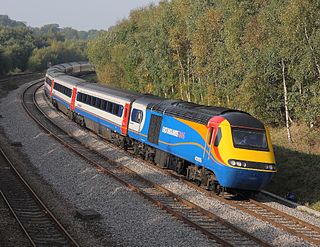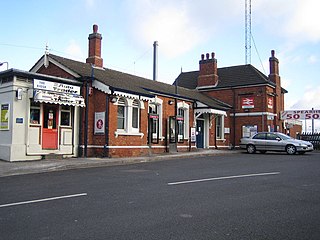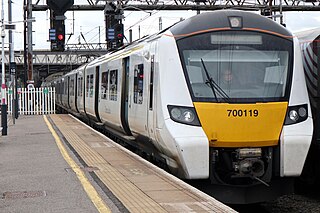
Thameslink is a mainline route on the British railway network, running from Bedford, Luton, St Albans City, Peterborough, Welwyn Garden City, London Blackfriars and Cambridge via central London to Sutton, Orpington, Sevenoaks, Rainham, Horsham, Three Bridges, Brighton and East Grinstead. The network opened as a through service in 1988, with severe overcrowding by 1998, carrying more than 28,000 passengers in the morning peak. All the services are currently operated by Govia Thameslink Railway. Parts of the network, from Bedford to Three Bridges, run 24 hours a day, except on early Sunday mornings and during maintenance periods.

Gatwick Express is an express rail passenger service between London Victoria, Gatwick Airport, Haywards Heath and Brighton in South East England. It is the brand name used by the Govia Thameslink Railway train operating company on the Gatwick Express route of the Thameslink, Southern and Great Northern franchise.

Southern is the brand name used by the Govia Thameslink Railway (GTR) train operating company on the Southern routes of the Thameslink, Southern and Great Northern franchise in England. It is a subsidiary of Govia, a joint venture between transport groups Go-Ahead and Keolis, and has operated the South Central franchise since August 2001 and the Gatwick Express service since June 2008. When the passenger rail franchise was subsumed into GTR, Southern was split from Gatwick Express and the two became separate brands, alongside the Thameslink and Great Northern brands.

The Midland Main Line (MML), sometimes also spelt Midland Mainline, is a major railway line from London to Sheffield in Yorkshire via the East Midlands. It comprises the lines from London's St Pancras station via Leicester, Derby/Nottingham and Chesterfield.

Blackfriars, also known as London Blackfriars, is a central London railway station and connected London Underground station in the City of London. It provides Thameslink services: local, and regional and limited Southeastern commuter services to South East London and Kent. Its platforms span the River Thames, the only one in London to do so, along the length of Blackfriars Railway Bridge, a short distance downstream from Blackfriars Bridge. There are two station entrances either side of the Thames, along with a connection to the London Underground District and Circle lines.

East Croydon is a railway station, tram stop and associated bus station in Croydon, Greater London, England. It is located in Travelcard Zone 5. At 10 miles 28 chains from London Bridge, it is the 20th busiest station in Britain, was the 10th busiest in 2020–21, is the busiest national rail station in London outside of fare zones 1 and 2 and is one of the busiest non-terminal stations in the country. It is one of three railway stations in the London Borough of Croydon with Croydon in their name, the others being West Croydon and South Croydon. A Tramlink tram stop is located immediately outside the main station entrance.

Brighton railway station is the southern terminus of the Brighton Main Line, the western terminus of the East Coastway Line and the eastern terminus of the West Coastway Line in England, and the principal station serving the city of Brighton, East Sussex. It is 50 miles 49 chains from London Bridge via Redhill.

The British Rail Class 377 Electrostar is a British dual-voltage electric multiple unit passenger train (EMU) built by Bombardier Transportation on its Electrostar platform at Derby Litchurch Lane Works from 2001 to 2014.

The Brighton Main Line is a railway line in southern England linking London to Brighton. It starts at two termini in the capital, London Victoria and London Bridge, and the branches from each meet at East Croydon, from where the route continues southwards via Gatwick Airport to the coast. The line serves the suburbs of South London, as well as the towns of Redhill, Horley, Crawley, Haywards Heath and Burgess Hill.

Dormans railway station is on the East Grinstead branch of the Oxted line in southern England. It serves Dormansland and Dormans Park in Surrey. Most trains run between London Victoria and East Grinstead and are operated by Southern. Thameslink trains call at peak times on weekdays.

Bedford railway station is the larger of two railway stations in the town of Bedford in Bedfordshire, England. It is on the Midland Main Line from London St Pancras to the East Midlands and the terminus of the Marston Vale line from Bletchley through Bedford St Johns.

Luton Airport Parkway station is on the Midland Main Line in England, serving south Luton and Luton Airport in Bedfordshire. The station is situated in Luton's Park Town district, being 29.27 miles (47.11 km) from London St Pancras between Harpenden to the south and Luton to the north. Its three-letter station code is LTN, also the IATA code for the airport.

The British Rail Class 319 is an electric multiple unit passenger train built by British Rail Engineering Limited's Holgate Road carriage works for use on north–south cross-London services. These dual-voltage trains are capable of operating on 25 kV 50 Hz from AC overhead wires or 750 V DC from a third rail.

Stevenage railway station serves the town of Stevenage in Hertfordshire, England. The station is around 44.4 kilometres north of London King's Cross on the East Coast Main Line. Stevenage is served and managed by Great Northern, who operate Thameslink stopping services southbound to King’s Cross via stations such as Welwyn Garden City and Potters Bar, to Brighton and Horsham via central London and Gatwick Airport and to Moorgate via Watton-at-Stone, Hertford North and Enfield Chase and services northbound to Cambridge and Peterborough. It is also frequently served by London North Eastern Railway, who operate fast non-stopping services southbound towards London and northbound towards cities including York, Leeds and Edinburgh. Hull Trains and Lumo operate very limited services from the station.

First Capital Connect (FCC) was a British train operating company, owned by FirstGroup, that operated the Thameslink and Great Northern sectors from April 2006 to September 2014 which later became the Thameslink, Southern and Great Northern (TSGN) franchise.

Leagrave railway station is located in Leagrave, a suburb in the north of Luton in Bedfordshire, England. Leagrave station is situated on the Midland Main Line 33¾ miles (54 km) north of London St Pancras International. The station is managed by Govia Thameslink Railway, and is served by the Thameslink route.

The Thameslink Programme, originally Thameslink 2000, was a £6 billion project in south-east England to upgrade and expand the Thameslink rail network to provide new and longer trains between a wider range of stations to the north and to the south of London. The development facilitated new cross-London journeys, which means that passengers no longer have to change trains in London. Work included platform lengthening, station remodelling, new railway infrastructure, and new rolling stock. The project was originally proposed in 1991 following the successful introduction of the initial Thameslink service in 1988. After many delays, planning permission was granted in 2006 and funding was approved in October 2007. Work started in 2009 and was completed on 18 September 2020, although trains over the new routes began running in 2018.

The British Rail Class 700 is an electric multiple unit passenger train from the Desiro City family built by Siemens Mobility. It is capable of operating on 25 kV 50 Hz AC from overhead wires or 750 V DC from third rail. 115 trainsets were built between 2014 and 2018, for use on the Thameslink network, as part of the Thameslink Programme in the United Kingdom. As of 2021, they are operated by Govia Thameslink Railway.

Govia Thameslink Railway (GTR) is a British train operating company that operates the TSGN rail franchise. Within the franchise, GTR runs trains under the sub-brands: Thameslink, Great Northern, Southern, and Gatwick Express. GTR is a subsidiary of Govia, which is itself a joint venture between the British Go-Ahead Group (65%) and French company Keolis (35%).
Traingate is the popular name given to a 2016 disputed incident between Jeremy Corbyn, leader of the British Labour Party, and the train operating company Virgin Trains East Coast (VTEC) and its minority shareholder Richard Branson.



















